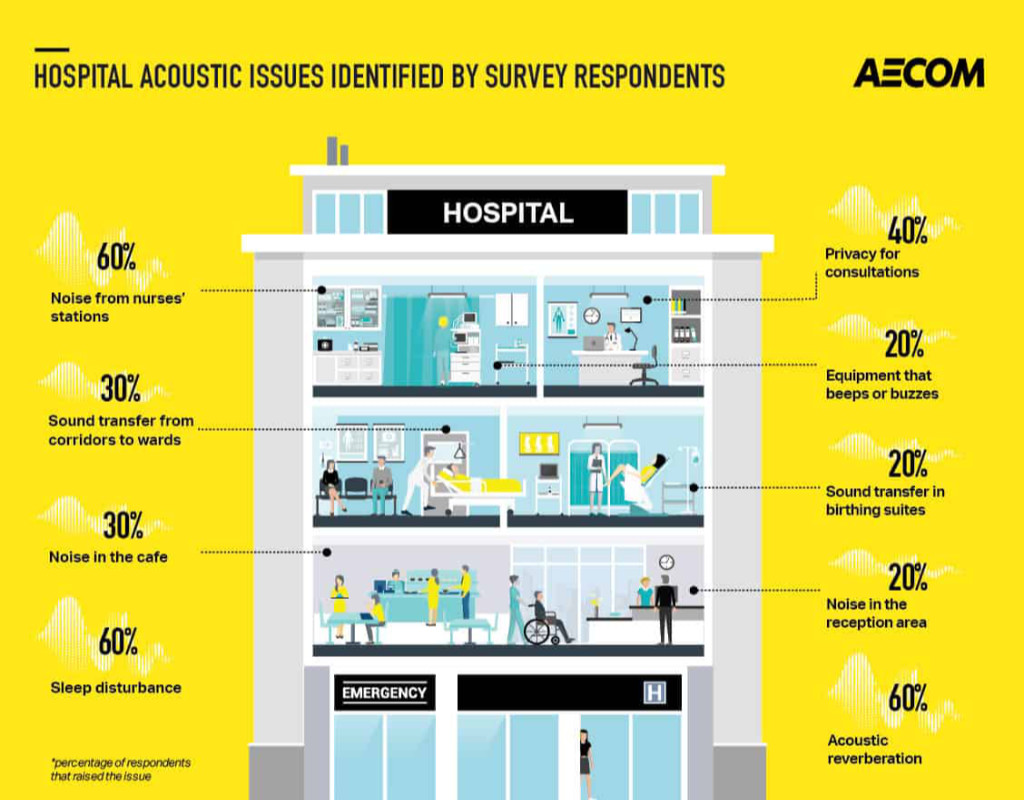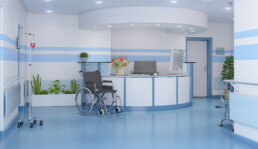Modern patient-centred care is not just about treatment modalities or technology advancements but also about the holistic environment in which patients are cared for. One vital yet often overlooked element in healthcare design is acoustics.
With the hustle and bustle in hospitals, noise can be a constant deterrent to patient healing, staff efficiency, and overall quality of care. But what if we told you that the design of a healthcare facility can play a pivotal role in managing this noise?
Attention to the details of the room is crucial because sound will always take the path of least resistance and, like water, will always find a way
Sharlee Van Tine, Director of Architecture, TONO Group.
At Shree Designs, our focus on healthcare architecture goes beyond just aesthetics. We believe in creating environments that foster healing; a significant part is ensuring optimal acoustics.
Let’s delve deeper.

Source: https://aecom.com/without-limits/article/acoustic-design-health-environments/
Acoustics in healthcare environments
The World Health Organisation suggests that the ideal background noise levels in hospital patient rooms should not exceed 35 decibels during the day and 30 decibels at night. However, research indicates that hospitals often surpass these guidelines, with noise levels reaching up to 85 decibels, equivalent to the sound of a vacuum cleaner.
Some studies have even documented noise peaks hitting an astonishing 120 decibels, comparable to the roar of a jet engine during take-off.
Why Acoustics is important?
Sound plays a pivotal role in healthcare environments. The Centre for Health Design highlights that both continuous ambient noise and sudden loud disturbances can profoundly impact patients and healthcare professionals. These effects include:
- Sleep quality/quantity,
- Pain perception,
- Elevated blood pressure and heart rate,
- Emotional exhaustion,
- Staff burnout
Solutions to Acoustic issues in Healthcare Design
Here are a few ways hospital architecture design and planning can help control noise levels on the premises.
1. Soundproofing Materials
The primary step in achieving a serene environment is employing soundproofing materials. Using acoustic ceiling tiles, wall panels, and flooring enhances the aesthetics and plays a crucial role in minimising sound transmission. Whether it’s the footsteps of a nurse rushing to attend to a patient or conversations between families, these materials ensure that sound doesn’t reverberate, providing a cocoon of calm. Such design intricacies, deeply rooted in hospital architecture, prioritise patient comfort at every turn.
2. Room Layout and Design
Strategic room layouts can work wonders in reducing noise. By separating noisy equipment from patient areas, we can ensure that the ambient sounds of beeping machines or rolling trolleys do not disrupt the tranquillity needed for recovery. Thoughtful healthcare design principles keep patient comfort in mind, making their stay more peaceful.
3. HVAC System Design
A well-thought-out HVAC (Heating, Ventilation, and Air Conditioning) system is pivotal for temperature control, but its role in noise reduction is just as vital. We can significantly control airborne noise by incorporating noise-reducing components during the healthcare design process. Furthermore, regular HVAC system maintenance ensures its quiet and efficient operation, safeguarding the calm environment we aim to establish.
4.Double-Entry Doors
Hospital corridors are bustling with activity, and noise can easily disturb patients and interrupt their healing process. Incorporating double-entry doors with sound seals and automatic closing mechanisms provides a solution that’s in line with state-of-the-art hospital interior design principles. They ensure the noise remains outside when caregivers or family members enter or exit a room, preserving the patient’s peace. It’s all about keeping disturbances at bay.
5. Acoustic Panels and Curtains in Operating Rooms:
Operating rooms are spaces of precision and concentration. Any disturbance or noise can affect the performance of the surgical team. By installing acoustic panels and curtains, integral to holistic health design, we can dampen sound and significantly reduce echoes.
This results in a quieter environment, allowing the surgical teams to focus entirely on their task, ensuring the best patient outcomes.
Effective acoustic design in healthcare is more than comfort; it’s a critical component in ensuring clear communication, reducing stress for staff and patients alike, and enhancing overall facility functionality
Kshititi Nagarkar, Shree Designs
Overcoming Obstacles in Noise Reduction
Architectural design for medical facilities faces unique challenges. Healthcare spaces prioritise easily cleanable and disinfectable surfaces, typically hard ones. Unfortunately, these hard surfaces also amplify sound. Here are a few solutions to overcome this problem.
- Incorporating softer materials in furnishings can offset this effect. Unlike hard surfaces that reflect sound waves, softer materials help absorb them. This absorption reduces the overall sound energy within a space, thus minimising echo, and background noise. Materials such as fabric, foam, or padded upholstery in furnishings can effectively reduce the reflection of sound waves.
- The “Sandwiching” Technique: One of the most effective strategies is layering or “sandwiching” construction materials. This involves using materials of different densities and absorption capacities for walls, floors, and ceilings.
- Utilising White Noise: Incorporating systems that produce white noise, such as HVAC equipment, can provide additional noise protection. Hallways, being accessible and more exposed, are ideal places for such installations.
Final Thought
The essence of healthcare lies in its ability to heal, rejuvenate, and bring solace. At Shree Designs, we understand that creating the right acoustic environment is crucial to providing the right healing environment through skilled and thoughtful healthcare design.
By integrating these principles, we ensure that our healthcare facilities aren’t just places of treatment but sanctuaries of healing. As healthcare architects, we’re not just building structures but crafting experiences, one sound wave at a time.
Related Posts
Optimising Operations and Safety
Fireproofing in Healthcare Design
Designing healthcare facilities isn't just about aesthetics—it's about ensuring the safety and…
Optimising Operations and Safety
Overcoming Unexpected Challenges in Hospital Design
The intricate world of hospital design is filled with unique challenges. From ensuring impeccable…
Optimising Operations and Safety
Navigational Design in Hospitals
Navigating a healthcare centre can be an overwhelming experience for patients and visitors alike.…
Optimising Operations and Safety
5 Patient-Friendly Designs for your Healthcare Facility
Healthcare organizations are shifting toward patient-centric design that gain not just patient…
Optimising Operations and Safety
5 Design Tips to Keep your Healthcare Facility Safe and Sterile
Stringent infection prevention and control measures in hospitals are rapidly becoming the norm in a…
Optimising Operations and Safety
Isolation Rooms – The Need of the Hour
Novel Coronavirus outbreak has left healthcare practitioners as well as the common man, concerned…
Optimising Operations and Safety
COVID-19 : Business Continuity Plan
Due to the outbreak of the unprecedented pandemic we at ShreeDesigns are conscious of the…
Optimising Operations and Safety
Social Distancing
Social distancing, a concept that has been around for ages, is one of the most vital measures…







